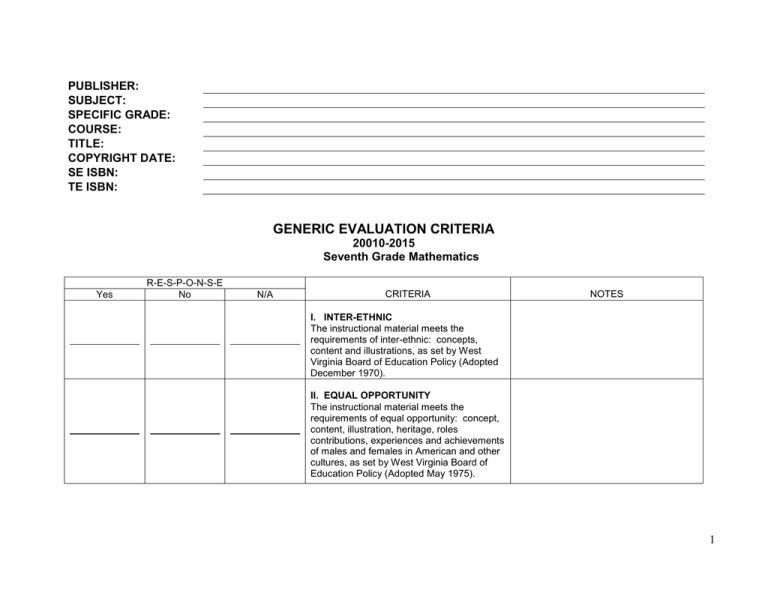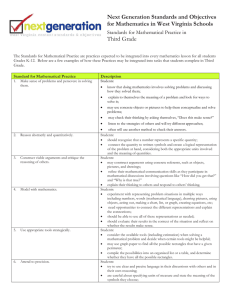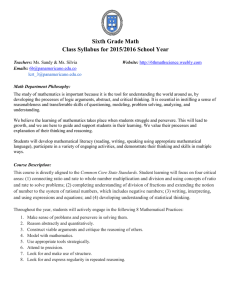GENERIC EVALUATION CRITERIA
advertisement

PUBLISHER: SUBJECT: SPECIFIC GRADE: COURSE: TITLE: COPYRIGHT DATE: SE ISBN: TE ISBN: GENERIC EVALUATION CRITERIA 20010-2015 Seventh Grade Mathematics Yes R-E-S-P-O-N-S-E No N/A CRITERIA NOTES I. INTER-ETHNIC The instructional material meets the requirements of inter-ethnic: concepts, content and illustrations, as set by West Virginia Board of Education Policy (Adopted December 1970). II. EQUAL OPPORTUNITY The instructional material meets the requirements of equal opportunity: concept, content, illustration, heritage, roles contributions, experiences and achievements of males and females in American and other cultures, as set by West Virginia Board of Education Policy (Adopted May 1975). 1 INSTRUCTIONAL MATERIALS ADOPTION: 21st CENTURY LEARNING EVALUATION CRITERIA GENERAL EVALUATION CRITERIA 20010-2015 Seventh Grade Mathematics (Vendor/Publisher) SPECIFIC LOCATION OF CONTENT WITHIN PRODUCT (IMR Committee) Responses I=In-depth A=Adequate M=Minimal N=Nonexistent I A M N In addition to alignment of Content Standards and Objectives (CSOs), materials must also clearly connect to Learning for the 21st Century which includes opportunities for students to develop A. Learning Skills Thinking and Problem-Solving Skills/ Rigor and Depth of Content Content is presented in a way that deepens student understanding through engagement in meaningful, challenging mathematics that builds on prior knowledge and promotes connections among mathematical concepts. Thinking and Problem-Solving Skills /Development of Conceptual Understanding Learning opportunities require students to develop their own viable mathematical understandings and help them build connections between mathematical ideas. Information and Communication Skills/Mathematical Language Appropriately introduce and reinforce in multiple ways all necessary terms and symbols. Personal and Work Place Productivity Skills 2 B. 21st Century Tools Problem-solving tools (such as spreadsheets, decision support, design tools) Communication, information processing and research tools (such as word processing, e-mail, groupware, presentation, Web development, Internet search tools) Personal development and productivity tools (such as e-learning, time management/calendar, collaboration tools) 3 INSTRUCTIONAL MATERIALS ADOPTION: 21st Century Learning EVALUATION CRITERIA The general evaluation criteria apply to each grade level and are to be evaluated for each grade level unless otherwise specified. These criteria consist of information critical to the development of all grade levels. In reading the general evaluation criteria and subsequent specific grade level criteria, e.g. means “examples of” and i.e. means that “each of” those items must be addressed. Eighty percent of the combined general and specific criteria must be met with I (In-depth) or A (Adequate) in order to be recommended. 20010-2015 Seventh Grade Mathematics (Vendor/Publisher) SPECIFIC LOCATION OF CONTENT WITHIN PRODUCT (IMR Committee) Responses I=In-depth A=Adequate M=Minimal N=Nonexistent I A M N For student mastery of content standards and objectives, the instructional materials will provide students with the opportunity to 4. Multimedia 1. offer appropriate multimedia (e.g., software, audio, visual, internet access) materials. 2. provide a website which provides links to relevant sites as well as lesson plans, student activities and parent resources. 4 3. Integrate technology seamlessly when appropriate to model mathematical situations, analyze data, calculate results, and solve problems. B. Scientifically-Based Research Strategies 1. Consistently require students to link prior knowledge to new information to construct their own viable understandings of mathematical ideas. 2. Consistently provide opportunities for students to solve complex problems that have multiple entry points and the possibility of multiple solution processes. 3. Consistently provide opportunities for students to communicate their mathematical thinking processes to others orally, in writing, or pictorially. 4. Routinely require students to develop and defend mathematical conjectures, arguments, reasoning and proof. 5. Provide opportunities for the students to be involved in investigations that enable them to make connections among mathematical ideas. 6. Expect students to develop multiple representations of the mathematics in order to depict reasoning used to explain real world phenomena or solutions to relevant problems and move fluently between those representations. 7. Present varied teaching models with emphasis on differentiated instruction in content, process, and product. 5 C. Critical Thinking 1. emphasize questioning models to promote higher order thinking skills based on depth of knowledge. 2. Consistently require students to discuss mathematics with each other and with the teacher, make arguments, conjecture and reason, and justify/clarify their ideas in writing and orally in precise mathematical symbols and language. 3. Present real world application that is current, engaging, integrated throughout the instruction, and promotes and develops critical thinking. D. Life Skills 1. address life skills (e.g., reading road maps, using reference tools, researching, reading a newspaper, using want ads, completing an application, applying the interview process and goal setting). 2. address habits of mind activities (e.g., literacy skills, interpersonal communications, problem solving and self-directional skills). E. Classroom Management 1. include opportunities for large group, small group, and independent learning. 2. Consistently require students to explore mathematical ideas, individually and collaboratively, while integrating the process standards (see Section I of this rubric). 3. provide suggestions for differentiated instruction (e.g., practice activities, learning stations, assessment, lesson plans). 6 F. Instructional Materials 1. Are organized according to WV content standards or other increments that allow students to investigate and explore major mathematical ideas; provide a variety of lessons, activities, and projects from which to choose; and emphasize connections between mathematical ideas. 2. Consistently integrate tasks that engage students and invite them to speculate and hypothesize, are open-ended, and require them to determine appropriate strategies. 3. Provide teachers with guiding questions to aid students’ development of mathematical discourse to further mathematical understanding. 4. Provide additional resources that are organized in a way that is easy to access and use. 5. Include various instructional models to address varied learning styles of students. 6. Provide extensive and varied opportunities to differentiate individual needs for skill-building. 7. Provide supplemental materials for intervention and enrichment. 8. Provide teachers with support to properly integrate the process standards using the available resources. 9. Include a teacher resource that builds content knowledge for the teacher. 10. Spiral previously taught skills and strategies with new content. 7 G. Assessment 1. provide assessment formats commensurate with WV assessment programs (e.g., WESTEST, NAEP, State Writing Assessment, informal assessments, PLAN, EXPLORE, ACT and SAT). 2. provide opportunities for assessment based on performance-based measures, open-ended questioning, portfolio evaluation, rubrics and multimedia simulations. 3. provide benchmark and ongoing progress monitoring. 4. provide rubric-based differentiated assessment. 5. provide an electronic system for managing assessment data to facilitate the implementation of tiered instruction 6. integrate student self-assessment for and of learning by providing tools and organizers that are linked to clearly identified learning goals. 7. Integrate formal and informal means of assessment in the materials for diagnostic, formative, and summative purposes. 8. include various types of assessments: performance tasks, multiple choice, short answer, and free response. 8 H. Process Standards 1. Problem Solving: Provide frequent opportunities for students to formulate, grapple with, and solve complex problems that require a significant amount of effort and have multiple viable solution paths. 2. Communication: Routinely challenge students to communicate their thinking to others orally, in writing, and/or pictorially, using precise mathematical language. 3. Reasoning and Proof: Provide frequent opportunities for students to complete mathematical investigations with and without technology; develop conjectures, mathematical arguments and proofs to confirm those conjectures. 4. Connections with Mathematics: Consistently establish connections, and provide opportunities for students to establish connections, among mathematical concepts and their real-world applications. 5. Representations: Provide frequent opportunities for students to develop multiple representations of the mathematics in order to depict reasoning used to explain real world phenomena or solutions to relevant problems and move fluently between those representations. 9 SPECIFIC EVALUATION CRITERIA Seventh Grade Mathematics Seventh grade objectives place emphasis on preparing students to take Algebra I in the eighth grade year. With less emphasis on paper/pencil computation, calculators are emphasized in all facets of the mathematics daily work as well as test situations. Review of all basic mathematics skills occurs in a relevant context. Problem solving is embedded in the curriculum, a variety of new concepts are utilized, and cooperative learning promotes communication skills. The West Virginia Standards for 21st Century Learning include the following components: 21st Century Content Standards and Objectives and 21st Century Learning Skills and Technology Tools. All West Virginia teachers are responsible for classroom instruction that integrates learning skills, technology tools and content standards and objectives Standard 1: Number and Operations Through communication, representation, reasoning and proof, problem solving, and making connections within and beyond the field of mathematics, students will demonstrate understanding of numbers, ways of representing numbers, and relationships among numbers and number systems, demonstrate meanings of operations and how they relate to one another, and compute fluently and make reasonable estimates. Standard 2: Algebra Through communication, representation, reasoning and proof, problem solving, and making connections within and beyond the field of mathematics, students will demonstrate understanding of patterns, relations and functions, represent and analyze mathematical situations and structures using algebraic symbols, use mathematical models to represent and understand quantitative relationships, and analyze change in various contexts. 10 Standard 3: Geometry Through communication, representation, reasoning and proof, problem solving, and making connections within and beyond the field of mathematics, students will analyze characteristics and properties of two- and three-dimensional geometric shapes and develop mathematical arguments about geometric relationships, specify locations and describe spatial relationships using coordinate geometry and other representational systems, apply transformations and use symmetry to analyze mathematical situations, and solve problems using visualization, spatial reasoning, and geometric modeling. Standard 4: Measurement Through communication, representation, reasoning and proof, problem solving, and making connections within and beyond the field of mathematics, students will demonstrate understanding of measurable attributes of objects and the units, systems, and processes of measurement, and apply appropriate techniques, tools and formulas to determine measurements. Standard 5: Data Analysis and Probability Through communication, representation, reasoning and proof, problem solving, and making connections within and beyond the field of mathematics, students will formulate questions that can be addressed with data and collect, organize, and display relevant data to answer them, select and use appropriate statistical methods to analyze data, develop and evaluate inferences and predictions that are based on models, and apply and demonstrate an understanding of basic concepts of probability. 11 (Vendor/Publisher) SPECIFIC LOCATION OF CONTENT WITHIN PRODUCT (IMR Committee) Responses I=In-depth A=Adequate M=Minimal N=Nonexistent I A M N For student mastery of content standards and objectives, the instructional materials will provide students with the opportunity to A. Number and Operations 1. provide examples and exercises to compare, order, and differentiate among integers, decimals, fractions, and irrational numbers using multiple representations (e.g., symbols, manipulatives, graphing on a number line). 2. provide opportunities to model the relationship between perfect squares and square roots using physical representations; to estimate square root and evaluate using technology. 3. provide opportunities to demonstrate fluency and justify solutions in performing operations with rational numbers including negative numbers for adding subtracting multiplying dividing, using simple computation and problem-solving situations. 12 4. provide examples and exercises to justify the use of the commutative, associative, distributive, identity and inverse properties to simplify numeric expressions. 5. provide examples and exercises to analyze and solve grade-appropriate real-world problems with whole numbers, integers, decimals, fractions and percents including problems involving discounts, interest, taxes, tips, percent increase or decrease, and to justify solutions including using estimation and reasonableness. 6. provide opportunities to use inductive reasoning to find and justify the laws of exponents with numeric bases. 7. provide examples and exercises to solve and interpret problems from real life contexts using numbers in scientific notation (positive and negative exponents) with and without technology. 13 B. Algebra 1. provide opportunities to use inductive reasoning to find missing elements in a variety of arithmetic and geometric patterns including algebraic sequences and series. 2. provide examples and exercises to evaluate algebraic expressions with whole numbers, integers, absolute value and exponents using the order of operations. 3. provide opportunities to solve problems by creating an input/output function table(including, but not limited to, spreadsheets) to predict future values, given a real-world situation involving rational numbers. 4. provide opportunities to analyze proportional relationships in real-world situations, to select an appropriate method to determine the solution and to justify reasoning for choice of method to solve. 5. provide opportunities to solve one-step linear equations and inequalities using a variety of strategies containing rational numbers with integer solutions; to graph solutions, and to justify the selection of the strategy and the reasonableness of the solution. 6. provide opportunities to plot lines within the Cartesian coordinate plane from a table of values to solve mathematical real-world problems. 14 7. provide examples and activities to determine the slope of a line from its graphical representation. 8. provide opportunities to represent algebraically and solve real-world application problems and justify solutions. 9. provide opportunities to identify a real life problem involving proportionality; make a hypothesis as to the outcome; develop, justify, and implement a method to collect, organize, and analyze data; generalize the results to make a conclusion; compare the hypothesis and the conclusion; present the project using words, graphs, drawings, models, or tables. C. Geometry 1. provide opportunities to identify and construct angle-pairs (adjacent, complementary, supplementary, vertical) congruent segments and angles perpendicular bisectors of segments angle-bisectors 2. provide opportunities to apply line symmetry to classify plane figures. 3. provide opportunities to apply rotations, reflections, translations to plane figures and determine the coordinates of its transformation and to compare and contrast the new figure with the original. 15 4. provide examples and exercises to pose and solve ratio and proportion problems including scale drawings and similar polygons. 5. provide opportunities to solve problems and explain the relationships among scale factor and area and volume including square of a scale factor cube of a scale factor 6. Provide examples and exercises to solve mathematical real-world problems using compound geometric figures. D. Measurement 1. provide opportunities to select and apply an appropriate method to solve (including, but not limited to, formulas) justify the method and the reasonableness of the solution, given a real-world problem solving situation involving perimeter circumference area surface area of prisms (rectangular and triangular) volume of prisms and cylinders distance and temperature (Celsius, Fahrenheit ) 2. provide examples and exercises to use the Pythagorean Theorem to find the length of any side of a right triangle and apply to problem solving situations. 16 3. provide examples and exercises to convert units of measurement, linear, area and volume, within customary and metric systems. E. Data Analysis and Probability 1. provide opportunities to determine theoretical probability of an event, make and test predictions through experimentation. 2. provide opportunities to determine combinations and permutations by constructing sample spaces (e.g., listing, tree diagrams, frequency distribution tables). 3. provide opportunities to collect, organize, graphically represent, and interpret data displays including frequency distributions, line-plots, scatter plots, box and whiskers, and multiple-line graphs. 4. provide opportunities to analyze and solve application problems involving measures of central tendency (mean, median, mode) and dispersion (range) from data, graphs, tables, and experiments using appropriate technology to compare two sets of data. 17








